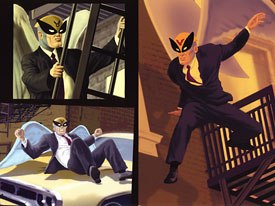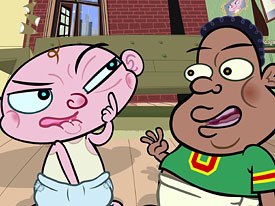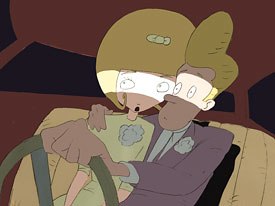Joe Strike surveys the animation landscape of New York City to see how independent artists are building business in the Big Apple.

New York may never become an animation mecca to rival Los Angeles, but its homegrown cartoon industry has been enjoying a sustained growth spurt as of late. Established companies, recent startups and a growing pool of freelance talent are all benefiting from an increased demand for animation. Low cost desktop technology, new distribution platforms, New York-based ad agencies and cable channels have all contributed to the boom. Today a talented, well-networked animator can stay quite active, while one with a head for business can set up shop and cultivate an identity and a style that will attract clients.
The last two years or so have been amazing. Animation has been a very busy business here in New York, an upbeat Nathan Graf, Noodlesoup Productions ceo enthuses. As befits someone who specialized in decision sciences at PricewaterhouseCoopers before joining Noodlesoup, Graf is aware how short and long business cycles can affect a business. According to Graf, the early to mid 1990s were the MTV years, the previous boom in New York animation. Once that scene cooled, a lot of those things shuttered, at least temporarily. There was a general downward trend, a bit of a flight out west by the talent here. Then there was the Internet thing, which burst of course.
Noodlesoups business strategy to protect itself from financial ups and downs has taken it in several directions. Were both a service shop and producers of original content, according to Graf. The four-year-old company enjoyed its first success early on producing The Venture Brothers for Cartoon Networks Adult Swim. Since then, the studio has produced a handful of pilots on a service contract basis, including the Independent Film Channels first long-form animated project, the Bob Balaban-created Hopeless.
Graf says that New York-based clients like Spike, MTV and Comedy Central, know having a production staff a couple blocks away versus 3,000 miles is good. Noodlesoup has as of late, spent a lot of our efforts focusing on the commercial world. If youre going to justify working in and paying New York City rent, Madison Avenue work is one way. They also like walking down the block to a service house. The company now has five on-staff and five external directors it represents to advertising clients. Were trying to reinvent ourselves, partially. Its the same core competency of telling a story, whether its 30 seconds or 30 minutes of animation.

J.J. Sedelmaiers advice to aspiring animation moguls is to, stay small; you can ride out slow periods and not have to take work that will harm your reputation. Thanks to Beavis and Butt-Head and Saturday Night Lives TV Funhouse segments, J.J. may be one of Americas best-known independent animators. Based in White Plains, a half-hour north of Manhattan, Sedelmaier has actually pulled back from the SNL segments that put his studios name on the map. They were grueling to produce. We worked on tight budgets and schedules and then people started thinking thats all we did.
Diversification has served Sedelmaier well. Commercials are our bread & butter thats what we do best, he explains from an office overflowing with pop-culture memorabilia. But we have multiple existences: were also known for starting SNL cartoons & doing things like Beavis & Butt-Head and Harvey Birdman. As befits an alumnus of R.O. Blechmans legendary Ink Tank studio, Sedelmaier is also heavily involved in print and design/illustration work. (One of his specialties is adapting artists as diverse as Don Martin and Al Hirschfeld into animation.) Thats whats nice about being well known and doing distinctive work: [clients] want to work with you, and thats ultimately where you want to be.
Richard OConnor opened Asterisk Animation a year and a half ago in New Yorks Silicon Alley a neighborhood in the West 20s, home to numerous new media and graphic design firms. Sometimes the client doesnt have a lot of money, but if we like the project and we like the people, we can figure out a way to make it work, he says. One of the benefits of being independent is the ability to make that decision. Were not going to make a lot of money on it, but were going to have fun doing it.
Pulling in the bucks is almost a secondary goal for OConnor, quoting Citizen Kanes adage its not hard to make a lot of money if all you want to do is make a lot of money. He shrugs off one of his shops early projects for which I havent seen five cents yet, but I made sure all my artists were paid. If any money comes in, itll be a nice if unexpected treat.
Aaron Augenblicks self-named studio is located Down Under the Manhattan Bridge Overpass, or as its otherwise known, Brooklyns waterfront DUMBO neighborhood. Were now in a larger space since the first tiny little hovel we had in 1999. Starting an independent business like this, you have a lot of struggle in the first few years, he recalls. Hopefully some of our early freelance work will never see the light of day again. But no matter how terrible it was, we were always able to do something with it in our own voice.
It helped that from day one we were doing independent films alongside all our freelance work. As you do more work with a personal point of view people start to gravitate towards that. Now were beginning to sell projects were actually interested in working on versus scraping for anything that comes by, which weve done a lot of.

Augenblicks most seen work may be the animated stand-up riffs on Comedy Centrals Shorties Watching Shorties (a second season is in the works), followed by segments for the kids show send-up Wondershowzen on MTV2. There used to be a small handful of really big studios which didnt have a signature point of view, and fell by the wayside in favor of smaller shops, he theorizes, perhaps referring to MTVs animation division where his career started. I think thats a great thing. Now with technology and the industry running the way it is, theres more of an opportunity for smaller studios to do things with a voice.
Two New York animation companies have found success without turning to Madison Avenue or concocting Adult Swim-worthy satire, but by creating works for very young audiences.
To reach Michael Sporns basement studio, you have to descend a flight of stairs under a Greenwich Village storefront and traverse a narrow walkway between two buildings. Its as if youve suddenly left New York for the back alleys of London or Prague, and it may be the perfect environment in which to create cartoons based on classic childrens literature.
Sporn jests that doing kids films and adapting kids books is a large part of my very meager bread and butter. Its more like bread and Parkay, actually. A sardonic sensibility does little to disguise his passion and belief in his work. For 25 years his company has been creating animated gems brimming with heart and sincerity. Several of his films have been based on the works of childrens author and illustrator William Steig (Sporn had nothing to say about DreamWorks Hollywoodization of Steigs Shrek), including his Oscar-nominated adaptation of Dr. DeSoto. (I had no work for a year after the nomination except for one short, so that shows how helpful the award was.)
A steady series of productions for HBO and Weston Woods, as well as specials for CBS and other outlets has kept his small studio plugging away. More recently, Sporn has provided art and animation for a series of Scholastic DVD programs, and segments for PBSs Between the Lions.
While Sporn can jest about spending and losing $100,000 of his own money on an early production, he can turn around and just as easily describe the arcane details of financing his films and participating in their profits. He and his studio are currently in pre-production on their first animated feature, a biography of Edgar Allan Poe that Sporn hopes to produce over the next two-three years on a $500,000 budget. A friend put in $200,000 to jumpstart work, but who knows how long it will take finish? We have to get the bread and Parkay jobs along the way.

Longtime Sesame Street writer/producerJosh Selig launched Little Airplane five years ago to create live-action programming for the preschool market. After a stint as head writer on Nick Jr.s Little Bill series, he expanded into animation production. I had previously thought of it as fast and furious, Road Runner style action, but with Little Bill, I realized the medium could develop characters & tell rich stories.
Today the lower Manhattan, Tribeca-based companys animated output includes shows and interstitials for Nick Jr., Playhouse Disney and Discovery Channel. Clients come to their door with specific projects, as Nick Jr. did when they needed an on-air host; the companys creation, Piper OPossum, is on his way to appearing in some 150 interstitials. Little Airplane also develops and sells their own properties to the preschool market, placing Wonder Pets on Nick Jr. and Go Babies on Playhouse Disney.
We have a house brand, says Selig, our own shows. He credits his partner, Little Airplanes creative director Jennifer Oxley for bringing in former staffers from Little Bill and Blues Clues. Twenty of the companys staff of 50 do animation, design and storyboard work. Expansion allowed us to bring people on fulltime, and to give them full benefits. We want to build up loyalty & make them feel like part of the team.
Little Airplane is unusual in keeping a large, in-house staff. One of best ways to keep overhead low is to have a minimum number of fulltime employees. By and large, New York animation producers reach for their rolodexes when projects come through the door but it often seems as if everyone knows everybody already. Generally, theres one degree of separation between you and the person you need, according to Augenblick. Its sort of a communal thing New Yorks good that way. Asterisks OConnor describes it as a network, thats kind of clubby, but not exclusive. You go to the same parties and screenings, while Graf observes youd be hard-pressed to find two experienced producers in the city who dont have similar lists [of people] they first call on for a project.
My personal process, and what Ive observed from colleagues is that at some point we all worked for the same big company, says Kimson Albert, currently working as an animation director on Venture Brothers at Noodlesoup. When youre associated with a big studio, you gain experience and you make contacts that stick with you along the way, so people tend to know each other.

Word of mouth spreads pretty fast when somethings setting up, he continues. Its not send in your résumé the production manager has a list of names, and the person he calls knows someone else.
The more people Ive gotten to know, the easier its getting, confirms Fran Krause, a digital animator at Curious Pictures. Three or four years ago I had to call everyone I knew, I had to sell the hell out of myself. For the last three years Ive been a commodity I havent had to look for work now for a while. Its a boom thats driving up wages, according to Graf. In the near term its been kind of a pinch for studios like us, but in the long term its great, it bodes so well for the industry.
Breaking into the ranks can be daunting, but it is far from a mission impossible especially at a time when labor is in demand. Step number one: make a damn good animated piece of your own, whether youre still in school or just starting out. Step two: dont bother sending it out unsolicited.
Ive been to offices where there are stacks of hundreds of DVDs and videos that will never get looked at, says Bill Plympton, New Yorks (if not the countrys) best-known independent animator. The key is the festivals thats where people find talent. [Buyers and producers] are all there, looking for product and looking to meet the animators. Plympton recommends Frances just-completed Annecy festival, (where he sought out short films for inclusion in four different animation compilations), as well as local festivals in New York City, Woodstock and Ottawa. When I find something I like, I go up to them and say give me your number, lets keep in touch.
Augenblick advises job seekers to just build a good website where they can digitize and display their work. The easiest thing for me when I get an e-mail is to click on a link. It takes two seconds and Ill know really fast if this person is a good match for the job.
Joe Strike is a NYC-based writer/producer with a background in TV promotion and a lifelong interest in animation. He is writing a childrens novel.







